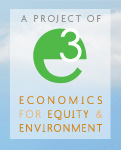By James Boyce and Manuel Pastor. Cross-posted on Triple Crisis.
There is good news and bad news about the clean energy transition. The good news is that half the new electric generating capacity installed worldwide in 2008-2010 was renewable. The bad news is that half wasn’t.
To avoid rapid global warming and its attendant human and economic risks, we need to accelerate the transition. We need to do more than slower growth in the use of fossil fuels: we need to cut their use substantially. This will require significantly ramped up investments worldwide in energy efficiency and clean energy.
One way to encourage this investment is to base public policies on the full range of benefits from reduced burning of fossil fuels – not only global benefits from reduced greenhouse gas emissions, but also local benefits from reduced emissions of particulates, nitrogen oxides, sulfur dioxide, carbon monoxide, mercury, benzene, and other toxic pollutants.
In the European Union, research has shown that the clean air benefits alone are sufficient to justify investments in energy efficiency and renewables. “The welfare effects of climate policy seem to be positive,” a 2006 report for the Netherlands Environmental Agency concluded, “even when the long-term benefits of avoided climate impacts are not taken into account.”
The clean air co-benefits of climate policy may be even greater elsewhere, in countries with less stringent air pollution controls than Europe. In a recent study we cite World Bank data indicating that in the United States the human health damages from particulate emissions are six times higher per ton of carbon dioxide than the average for Germany, France and the United Kingdom. In China, the ratio is more than ten times higher. (more…)

